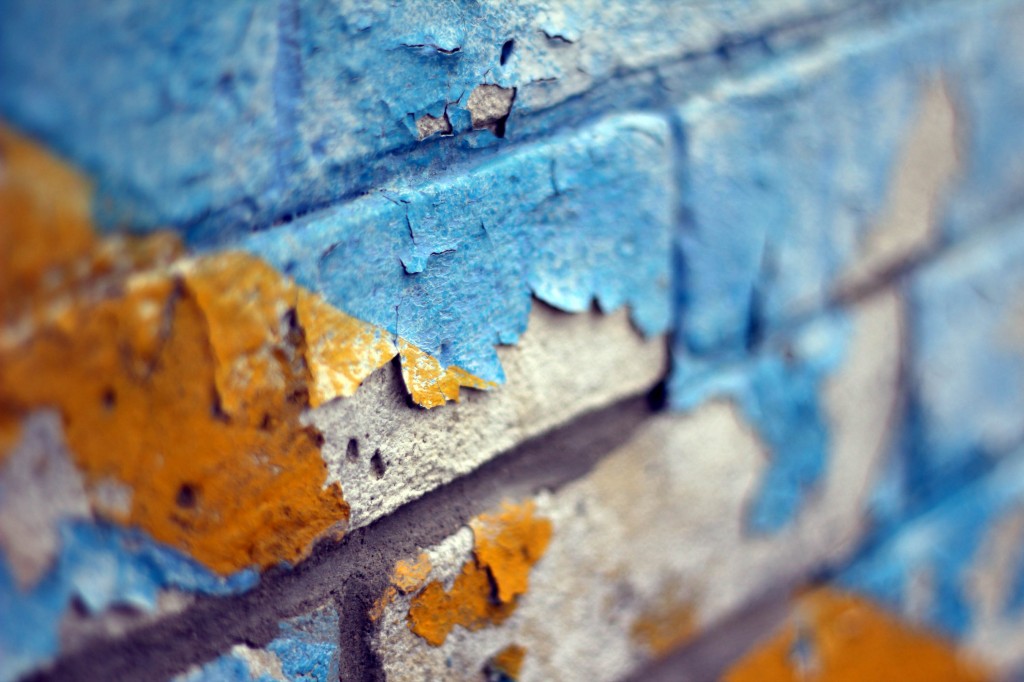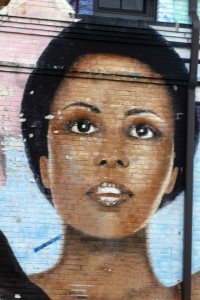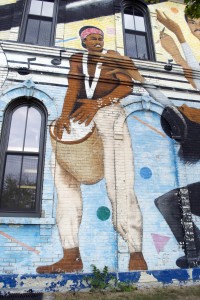
A renowned Milwaukee mural represents a neighborhood’s plight and pride
By: Emily Connor
The cream-colored brick wall sits squarely between the artist’s thumb and forefinger. Cars are speeding past going north on Interstate 43. But Reynaldo Hernandez doesn’t notice. He keeps staring straight ahead at 642 W. North Ave., the Inner City Arts Council building. It’s a perfect vantage point to see the mural he’s planning. He’s spent months designing. But the real work is yet to come.
It’s 1984. Intense violence and crime has plagued Milwaukee. The city has admitted it has a gang problem. They’ve sent a group of reluctant kids to Hernandez for the summer. And they’ll get paid to paint this mural—an homage to the Bronzeville neighborhood of Milwaukee.
Now, the challenges have changed. It’s over 25 years later. And you can’t see their faces. Many don’t know their names. You don’t know their stories or where they live now, but you do see their brush strokes. In the shape of an eye, dark and piercing, looking up toward the horizon. In the gleam of a trumpet, shiny and brass. In the pale blue background, a canvas of more than just the now-chipping acrylic paint.
No, you don’t know the girls and boys, at-risk youth and gang members, who worked long afternoons, breaking through their limits and barriers to discover hope and understanding with the help of their mentor, artist Reynaldo Hernandez. But you do see their triumph and all that it represents amid today’s turbulent economic times. It’s the Inner City Arts Council Mural.

Photo by: Sam Easton
The Bronzeville of Today
I take the exit off I-43 for North Avenue, and I can see her eyes, the woman looking out from the Inner City Arts Council Mural. She’s on the far right of the two-story mural, next to a trumpet player, an artist with a paintbrush, dancer and a traditional African mask. But something’s stretched across the top of the woman’s forehead. I pull to the side of 642 W. North Ave., and I look closer to read the banner placed on the building: The Vanguard Group.
This building where the mural resides once housed the Milwaukee Inner City Arts Council, a thriving organization that planned artistic events, festivals and provided art, dance and photography lessons for the neighborhood. But after a lack of leadership and funding caused the organization to shut down in the late 1990s, the building sat vacant, boarded up for nearly 10 years.
The Inner City Arts Council Mural now resides just on the edge of the Bronzeville Cultural and Entertainment district, a neighborhood project currently under development in Milwaukee. Many could drive past the neighborhood today, never knowing what it once was in the 1950s and 60s: a bustling community and cultural hub of African-American music, art and talent. Construction of I-43 in 1968 devastated the community, effectively splitting the predominately African-American neighborhood in half. More than 8,000 homes were eliminated. As property values decreased, community members packed their bags and left.
But the community felt a revival when the Inner City Arts Council moved into 642 W. North Ave. in 1976. For decades, the Council helped plan community events and foster the same pride in art the old Bronzeville captured and their mural represents—a feeling slowly fading since the Council’s demise and an era of new economic challenges emerged.
“The city is still hurting because the Inner City Arts Council is not around…I used to teach out of the building,” muralist Reynaldo Hernandez remembers.
Hernandez’s artwork can be seen in over 100 murals around the state, hallmarks of a career spanning nearly 50 years. Sitting in his studio in Harambee, the neighborhood just north of the Bronzeville redevelopment zone, he is surrounded by hundreds of paintings—a lifetime of work, achievement and talent—resting in a single studio space.
Hernandez is right. The Inner City Arts Council’s closing created a chasm in the community, doubled down by the economic recession and the closing of the Black Holocaust Museum in 2008, after the death of its director. When the redevelopment project began, recovery for the Bronzeville area seemed bleak.
In its prime, the Inner City Arts Council created a sense of community spirit and pride. The 6th District Alderwoman Milele Coggs, who oversees the current Bronzeville redevelopment area, remembers taking art classes there as a child. She grew up just north of Bronzeville, only a few blocks away from Hernandez’s current studio.
She smiles as she describes an annual festival the Inner City Arts Council held in East Town, an area of Downtown Milwaukee, when she was young. “In the middle, for the kids, they had free canvasses, and you could just sit there and paint,” she remembers fondly.
The Bronzeville Cultural and Entertainment District redevelopment plan officially began in 2005. Initially, growth remained stagnant, as the economic recession hit full force in 2008. But the purchase of the old Inner City Arts Council building in 2010 by an investment firm for the use of The Vanguard Group presented an opportunity for growth. The closing of the Council hurt the community, but drawing new business would be ideal for the creation of a viable arts and cultural district.
Milwaukee had set aside $3.5 million as a redevelopment initiative, a portion of which was allotted for real estate acquisition. The city loaned $171,000 to The Vanguard Group. After spending about $700,000 to redevelop the building, The Vanguard Group opened its offices in February 2012 in the old Inner City Arts Council building. Yet, they hadn’t erased the iconic mural. The woman’s eyes still look out over northbound cars on I-43.

Photo by: Aimee Katz
Inspiring Through Art
At first they fought. They rebelled. They had an image, and they sought to protect it. The psychology at play was a huge factor. But it was just the beginning in the summer of 1984. Hernandez knew the rebellious kids he was working with would be proud once their work was completed.
He told the City of Milwaukee the young girls and boys should be compensated for their work on the Inner City Arts Council Mural. “To teach them you have to work to get paid,” remembers Hernandez.
He already spent months prior designing the mural with large images so it could be seen from the freeway. He worked to incorporate the building’s windows and other obstacles into his piece – a signature of his style as an artist. Hernandez struggled with the important task of bringing color and life into the community. He had stiff competition—“All the garbage in the inner city from billboards, a lot of cigarette and tobacco ads, “ says Hernandez. But his piece would speak to Bronzeville’s history.
“It has the Mask of Benin, the African mask on the left side, going in to the future,” says Hernandez of the design of the mural. The mural displays African-American art forms, music, literature and painting. It would be an inspiration, honoring the community and the work of the Inner City Arts Council. But the arduous process, of molding young minds by making a mural, was a difficult endeavor.
“The kids would challenge you. It was crazy. They got on their bikes, their little bikes and would get on the freeway,” remembers Hernandez, as he describes the season spent working with the kids painting the mural. But each day they continued, forging ahead to finish the treasured piece. Inspiration was key, to motivate and keep the project going.
It may take thousands of brush strokes to turn a humble wall into a work of art. But with persistence and patience, opportunities unfold. “These kids learn that there is more to life than street activities and sports. You can develop the talents you have and expand your horizons,” says Hernandez.
Deborah Cabanatuan, an art specialist who worked in some of the inner-city Milwaukee schools, would bring her students to 642 W. North Ave. that summer. She and her students looked in awe, “as we would watch the astonishing transformation of a plain corner cream city brick building into a magnificent piece of art.”
The Bronzeville of Tomorrow
Sitting in his Harambee studio, Hernandez reflects on the Inner City Arts Council Mural and its place in the Bronzeville community. “It represents what they’re about—what they were about.”
When The Vanguard Group first began renovating the building, they had plans to remove the mural. But the community spoke. With Coggs’ help, the community made it clear the mural should stay. Now, Coggs said The Vanguard Group has committed to keeping the mural in some form.
“Because of the inclusion of the community it makes it clear to any developer what the priorities of the community are and my priorities as a representative of the community,” said Coggs.
Yet, progress remains slow. Unfortunately, the current economy has made development “an arduous, time-consuming and time-taking experience,” according to Coggs.
But it’s not about speed; it’s about the quality of redevelopment, and keeping history and culture alive. Coggs believes Bronzeville as an arts district will truly thrive on a basis of mixed use. While theaters, cultural centers and art galleries may line the streets, she envisions apartments and office space intermingling, to spur economic growth and bring consumers to the area.
Yet in the end, Coggs believes maintaining the area’s history is an important piece of the project puzzle. “It is always important to pay tribute to an area, to a building, a history of time,” said Coggs. “I think the mural is iconic, the very location of it off of the highway. It has become an identifying marker to visitors and to residents.”
“And it’s a beautiful piece of artwork,” she adds.

Photo by: Sam Easton
Lasting Impressions
For Hernandez, he knows art isn’t just about the beauty and aesthetic qualities. It’s inspiration and influence runs deeper.
“Murals are about giving back to the community and instilling pride in the working class people. A lot of times, people around here, some neighbors would say ‘why are you putting a mural around here, nobody cares about this area.’ But then, once you complete it, they start fixing up their own yards,” he says. “It’s a domino effect.”
Today, Hernandez continues his work, interacting with and teaching students to design and paint murals all across Wisconsin. After decades of painting and teaching at-risk youth, arduously working to show the opportunities ahead, Hernandez says the lasting impressions are what really matter. “I get satisfaction just by meeting students that have grown up and are themselves good citizens of the world,” says Hernandez.
Years after the Inner City Arts Council Mural was completed, Hernandez was in northern Wisconsin, on the UW-Stout campus, working on a new mural. As he stepped out of his car and walked from the parking lot, he heard a young woman yelling behind him.
“Mr. Hernandez! Mr. Hernandez!” she called. He turned to see a young woman running toward him. She stopped. She was there to thank him. She was one of the young women, one of the gang members, who helped paint the Inner City Arts Council Mural. She was now a student at UW-Stout.
“Just that experience—painting the mural—influenced her to see there is more than just life in the ghetto,” remembers Hernandez. “She learned you could get out and expand your horizons.”
He smiles. “That makes me happy.”
It’s been over 25 years since the Inner City Arts Council Mural was painted. Today, we don’t know where they are. Many don’t know their names. But we see their work. The work of those students, gang members and at-risk youth. We see their pride in the community and hope to see it for years to come. It’s an emblem of history. A symbol of what Bronzeville could be once again. An homage to an arts and entertainment district sitting on the side of 642 W. North Ave.
Related Posts:
